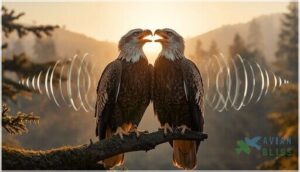This site is supported by our readers. We may earn a commission, at no cost to you, if you purchase through links.
If you’ve ever watched a pair of eagles circling high above their nest, you might assume their partnership is as fleeting as the wind. But here’s the twist—more than nine out of ten eagle pairs stay together, season after season, forging bonds that can last decades.
Their loyalty isn’t just for show; it’s the secret behind their exceptional parenting, synchronized flights, and fierce territory defense. Understanding whether eagles mate for life isn’t about romance—it’s about survival, trust, and the intricate choreography of wild family life.
Let’s unravel the secrets behind these legendary pair bonds and see what really keeps eagle couples together.
Table Of Contents
- Key Takeaways
- Do Eagles Mate for Life?
- How Eagles Choose Their Mates
- Eagle Courtship Rituals Explained
- Nesting and Raising Young Together
- What Happens if an Eagle Loses Its Mate?
- Why Monogamy Benefits Eagles
- Frequently Asked Questions (FAQs)
- Do Eagles mate for life?
- Are bald eagles mates?
- How often do Eagles mate?
- How long do eagles stay with their partners?
- Can Eagles Remate after a mate dies?
- What happens if an eagle loses a mate?
- What do eagles do when their mate dies?
- Do eagles stay together as a family?
- What bird has only one mate for life?
- What is the most loyal bird to their mate?
- Conclusion
Key Takeaways
- Most eagle pairs stay together for life, with over 90% showing strong mate fidelity and long-lasting bonds.
- Lifelong partnerships boost breeding success, territory defense, and chick survival thanks to teamwork and experience.
- Eagles choose mates based on age, health, territory quality, and courtship displays like aerial cartwheels and vocal duets.
- If an eagle loses its mate, it often mourns briefly but will usually re-pair quickly to maintain breeding and territory stability.
Do Eagles Mate for Life?
Wondering if eagles really stick together for life? You’re not alone—this question comes up for anyone curious about these iconic birds.
Let’s look at what makes their relationships so unique.
Monogamy and Pair Bonding
When you think of eagles, picture a bond rooted in genuine teamwork. Most eagle pairs form long-term partnerships built on mate fidelity—over 90% stay together season after season.
Their monogamy isn’t just for show; it fosters trust, cooperative parenting, and synchrony in bonding behaviors. Studies show that eagles also engage in mate-guarding strategies to confirm paternity.
Divorce rates are low, and genetic monogamy remains remarkably high among these birds.
Lifespan of Eagle Partnerships
You can picture eagle partnerships as a tapestry woven over years—sometimes decades. Partnership duration hinges on mortality factors and environmental impact, but longterm bonds are common. Here’s what shapes their lifespan:
- Lifelong mate fidelity
- Site fidelity, often 15+ years
- Demographic trends favor older pairs
- Environmental stability boosts longterm survival
- Mortality is the main disruptor
Bald eagles need large territories, but habitat destruction impacts their populations.
Situations Leading to Mate Replacement
Longterm survival isn’t always guaranteed for eagle pairs—sometimes life throws a wrench in the works. Death or disappearance, nest failure, or territorial disputes can all trigger mate replacement. Incompatibility and infertility may lead to divorce, while extra-pair interactions add complexity.
Each factor that leads to mate replacement shapes how eagles adapt, ensuring their family line continues.
How Eagles Choose Their Mates
Choosing a mate is no small feat for an eagle—it’s a process packed with meaning and instinct. There’s more at play than just looks or luck. Here’s what matters most when eagles pick a lifelong partner.
Age and Readiness for Mating
Did you know bald eagles don’t even think about romance until they’re four to six years old? Sexual maturity age is key—most won’t attempt first mating until they’ve hit major developmental milestones, like full adult plumage. Here’s what shapes their readiness:
- Age compatibility
- Mating readiness indicators
- Reproductive window
- First mating frequency
- Experience-driven reproductive success
Territory and Physical Compatibility
In the context of mate choice, territory matters just as much as chemistry. Only healthy eagles with top hunting skills and strong physical traits can claim the best habitats, safeguarding food and future chicks.
Those compatibility factors—like wingspan, talon strength, and sharp eyesight—directly impact territory defense, nesting success, and even genetic compatibility over many breeding seasons.
| Compatibility Factor | Impact on Success |
|---|---|
| Habitat Quality | Sustains food, nesting |
| Physical Health | Allows territory defense |
Courtship Displays and Behaviors
Even before eagles pair up for good, their courtship rituals unfold in the sky and on the branch. Through daring aerial cartwheels, animated vocal duets, synchronized flights, and the tradition of gift giving, these majestic birds test and strengthen their bond. You’ll also spot mutual preening, revealing trust and a noteworthy level of intimacy between eagle pairs.
- Daring aerial cartwheels
- Synchronized flights
- Animated vocal duets
- Gift giving and mutual preening
Eagle Courtship Rituals Explained
Eagles don’t just pick a partner and settle down—they put on a whole show first. Their courtship is lively, bold, and sometimes a little breathtaking to watch.
Here’s what you can expect when love is in the air for these impressive birds.
Aerial Displays and Cartwheel Flights
Ever watched two eagles sky dancing, spiraling earthward, talons locked? That’s the cartwheel display—a breathtaking aerial acrobatics show. These courtship displays aren’t just for show; they test mate fitness, signal territory, and boost pair bonds. Display intensity, cartwheel risks, and population display trends all play a role in successful eagle partnerships.
| Display Type | Mechanics |
|---|---|
| Cartwheel Display | Talon-lock spiral |
| Display Intensity | Varies yearly |
| Mate Fitness | Tested mid-air |
| Cartwheel Risks | Rare injuries |
| Population Trends | Linked to success |
Vocal Communication in Pair Bonding
What keeps eagle couples so tightly knit year after year? It’s their duet call function—a vocal duet that’s as unique as a fingerprint.
Through vocal communication, each pair builds a vocal repertoire size that’s exclusive to their bond. Individual call signatures and call synchronization success help eagles respond to acoustic stimuli, reinforcing trust and intimacy with every courtship communication.
Gift Presentations and Synchronized Flights
Imagine watching two eagles exchange prey mid-air—these gift presentations aren’t just for show. Alongside paired soaring and dramatic flight patterns like the cartwheel display, these courtship rituals deepen bonds and boost reproductive success.
You’ll see species variation, too: bald eagles favor fish gifts, while synchronized flights and courtship displays vary by region, weaving intimacy into every aerial encounter.
Nesting and Raising Young Together
When raising a family, eagles work side by side through every step. Their teamwork shines brightest during nesting season. Here’s how these amazing birds handle the responsibilities together.
Cooperative Nest Building
Did you know some eagle nests weigh over a ton? In nest building, teamwork is key. Here’s how eagles pull it off:
- Both partners gather sticks, with females weaving them into the nest bowl.
- Trio Nesting sometimes occurs, boosting success.
- Material Selection ensures strength and comfort.
- Nest Reinforcement and nest renovation happen yearly, growing nest size and durability.
Egg Incubation and Parental Roles
Once the nest is sturdy, eagle parental care shifts to incubation. Both parents share parental duties, with females handling most direct incubation and males stepping in for relief.
Incubation duration averages 35 days, but environmental influences—like wind and rain—shape their behavioral adaptations. Parental cooperation ensures eggs are rarely left exposed, boosting hatching success and reflecting notable eagle nesting habits.
Feeding and Protecting The Chicks
After the eggs hatch, your attention shifts to chick feeding frequency and parental protection strategies. Eaglets can be fed up to eight times a day, with both parents juggling provisioning requirements and nest predation risks. Fast eaglet growth rates mean food resources are always in demand.
Parental care—guarding, shading, and feeding—plays a huge role in offspring survival and fulfilling parental responsibilities.
What Happens if an Eagle Loses Its Mate?
Losing a mate is a big turning point in an eagle’s life, and what happens next can shape the nest’s prospects.
Eagles respond in a few different ways, depending on the situation. Here’s what you can expect when an eagle faces this challenge.
Mourning and Re-Pairing Process
After losing a mate, eagles show real Grief Behaviors—long hours perched, sluggish routines, and even a dip in body temperature. Re-Pairing Speed varies, with some accepting a new partner within weeks, while others take months. Hormonal Impact delays readiness for a second clutch.
You’ll notice:
- Quiet mourning at shared perches
- Sudden Nest Departure by fledglings
- Increased Territory Turnover
Effects on Breeding and Nesting Success
When an eagle loses its mate, you’ll see breeding success take a hit. Cooperative parenting breaks down, and reproductive timing goes off track.
The surviving parent faces double duty—less efficient nest defense, patchy parental care, and lower offspring survival.
Mate loss impact ripples through every part of nest building and breeding behaviors, leaving reproductive success sharply reduced.
Divorce and Mate Switching in Eagles
Although most pairs stick together for years, divorce in eagles isn’t unheard of. Low reproductive success, poor territory, or age often spark mate replacement, with the re-pairing process usually happening quickly.
Switching trends rise in dense populations, but don’t always offer fitness advantages. These population impacts ripple outward, shaping mate choice and longterm partnership stability for the entire eagle community.
Why Monogamy Benefits Eagles
Eagle pairs stick together for good reasons that go beyond romance. Their lifelong bonds shape everything from raising chicks to defending their home turf.
Here’s how monogamy gives eagles a real advantage.
Increased Breeding Success
Ever wondered why lifelong eagle pairs are such successful parents? Pair experience leads to higher breeding success—experienced couples average 1.34 young per nest, compared to just 0.60 for newcomers. Here’s why monogamy works:
Lifelong eagle pairs raise more chicks per nest than newcomers, proving experience and monogamy boost breeding success
- Longterm partnership boosts parental care.
- Habitat quality improves reproductive success.
- Protection measures increase chick survival and support strong population trends.
Efficient Territory Defense
When you watch a mated pair in action, their cooperative behaviors really shine. By teaming up, they optimize territory defense—repelling intruder encounters and keeping boundary stability intact season after season.
Habitat factors and landscape effects shape territory establishment, but strong territorial behavior means most pairs defend their home efficiently, even as conditions change. That’s eagle territorial defense at its finest.
Enhanced Offspring Survival Rates
Imagine your odds of making it in the wild if both parents teamed up for every meal and defense. Parental cooperation and abundant food mean more chicks survive, especially when brood size grows.
With strong parental care, fledgling mortality drops, boosting long-term impacts on breeding success and reproductive success. That’s why monogamy and steady parental investment drive longterm survival for these notable birds.
Frequently Asked Questions (FAQs)
Do Eagles mate for life?
Bald eagles are famously monogamous, with mate fidelity rates over 85%. Longterm partnerships often last decades, only ending through mate death or rare divorce factors.
Their bond duration fosters re-pairing success, making eagle mating habits a model of devotion.
Are bald eagles mates?
Here’s the paradox: eagle pair bonds are fiercely loyal, yet nature sometimes forces them to “divorce” or re-pair.
Most bald eagles mate for life, demonstrating striking mate fidelity, monogamous habits, and longevity unless disrupted by loss or breeding failure.
How often do Eagles mate?
Eagles mate frequently throughout fertile windows in the breeding season, with daily mating common—especially mornings and afternoons. Copulation frequency rises to guarantee mating success and sperm viability, strengthening pair bonds in these monogamous birds.
Though mate replacement and “divorce” sometimes occur, these behaviors are exceptions to the general rule of monogamous pair bonding.
How long do eagles stay with their partners?
Life at the top of the food chain means forging bonds that can last decades—pair bond duration in eagles regularly stretches over a decade, with maximum longevity reaching 25 years.
Mortality impact triggers rapid mate replacement, highlighting resilient longterm partnerships.
Can Eagles Remate after a mate dies?
Yes, after a mate dies, you’ll see swift remating in some eagles—sometimes within days, especially where territory is crowded.
Gender differences, environmental pressures, and behavioral responses all shape the remating timeline and mate replacement process.
What happens if an eagle loses a mate?
Losing a mate sparks swift re-pairing, though re-pairing speed depends on partner availability. Breeding impact can mean fewer chicks, and behaviors shift as survivors defend nests.
Divorce rates rise slightly; mate replacement affects offspring survival, shaping long-term survival.
What do eagles do when their mate dies?
When a mate dies, you’ll notice mourning behavior—periods of lethargy and less hunting—before a rapid re-pairing process begins.
Territory retention becomes critical, and breeding impacts or even divorce factors often shape how quickly eagles recover.
Do eagles stay together as a family?
Think of an eagle family like a tightly woven nest—strong, but temporary. Eagles share parental duties and nesting habits until fledgling survival is assured.
Once young achieve independence, family bonding fades, though territorial fidelity often remains.
What bird has only one mate for life?
Some birds truly have only one mate for life. Mute swans, whooping cranes, and bald eagles are classic examples.
Their lifelong mates show striking species loyalty, practicing bird monogamy and mate fidelity through deep pair bonding and shared parenting.
What is the most loyal bird to their mate?
If you’re searching for the most loyal bird, albatrosses top the list—Albatross Fidelity exceeds 99%.
Swan Devotion, Vulture Monogamy, Goose Loyalty, and Lovebird Bonding also showcase noteworthy lifelong partnership and unwavering pair bonding in nature.
Conclusion
Like a well-rehearsed duet soaring on the wind, eagle pairs show us that loyalty isn’t just instinct—it’s a strategy woven into every aspect of their lives. When you wonder, do eagles mate for life, remember it’s not just about romance, but survival and teamwork.
Their enduring bonds shape the strength of their nests, the resilience of their young, and the legacy of their species. In the wild, lasting partnership is the thread that stitches generations together.
- https://ccbbirds.org/what-we-do/research/species-of-concern/virginia-eagles/facts-about-eagles/
- https://www.sciencedaily.com/releases/2005/07/050708061253.htm
- https://birdfact.com/articles/do-bald-eagles-mate-for-life
- https://en.wikipedia.org/wiki/Reproduction_and_life_cycle_of_the_golden_eagle
- https://www.audubon.org/news/do-eagles-remain-faithful-one-mate-their-entire-lives











